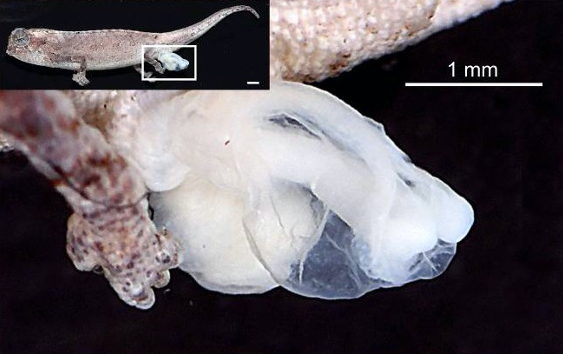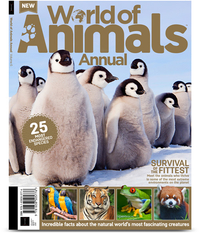World's smallest reptile fits on your fingertip
The Madagascar chameleon Brookesia nana measures half an inch long, and may be critically endangered.

The world's smallest male reptile can fit right on your fingertip — if its massive genitals don't get in its way.
Meet Brookesia nana, an extremely tiny species of chameleon from the rainforests of northern Madagascar. Researchers recently described one male and one female of the species in a study published Jan. 28 in the journal Scientific Reports, and they were stunned by the male's particularly wee dimensions. Measuring just half an inch (13.5 millimeters) from snout to cloaca (that's the multipurpose hole reptiles use for both excretion and reproduction), the fully grown male is the smallest adult reptile ever described.
In fact, the male B. nana measured even smaller than his female counterpart, which had a length of 0.75 inches (19.2 mm) from snout to cloaca. (Not only is she longer than her mate, but she is also slightly longer than the Caribbean gecko Sphaerodactylus ariasae, which currently holds the title for smallest female reptile, the researchers wrote.)
World of Animals Annual: $22.99 at Magazines Direct
The animal kingdom is a fascinating, beautiful and complex world, but it faces an uncertain future. In the past few years, we’ve seen Japan resume whaling and scientists warn that the next decade could prove pivotal for the Earth’s environment and its inhabitants. This annual explores some of the threats faced by 25 of the world’s most endangered creatures and meets the animals that owe their continued existence to the vital Endangered Species Act of 1973.
Related: Photos of the amazing animals that call Madagascar home
"Given that the general body plan of reptiles is rather similar to that of mammals and humans, it is fascinating to see how miniaturized these organisms and their organs can get," lead study author Frank Glaw, a herpetologist at the Bavarian State Collection of Zoology in Munich, told Live Science in an email.
Not every organ is so miniaturized, though. Male lizards and snakes have a pair of reproductive organs called hemipenes — two tubular genitals that stay inverted inside the male's body, until it's time to mate. B. nana's hemipenes measured 0.1 inches (2.5 mm) long when fully everted, or roughly 18.5% of his total body length.

Surprisingly, this is not an unusual trait among the world's tiniest lizards, the researchers wrote. Genital length among related chameleons ranges anywhere from 6.3% to 32.9% of the male's total body length, with an average of 13.1% over 52 species, the team found. (Other animals have much greater genital-to-body-size ratios, including ducks, whose genital length can equal their body length, and barnacles, whose genitals can be eight times longer than their bodies, the researchers noted).
Sign up for the Live Science daily newsletter now
Get the world’s most fascinating discoveries delivered straight to your inbox.
"[This] revealed an interesting pattern: The smallest species often have the proportionally largest genital sizes," study co-author Mark Scherz, a herpetologist at the University of Potsdam in Germany, wrote in a blog post.
Why might this be? According to Scherz, it could be related to the size dimorphism between males and females of these tiny reptile species. Even if the female remains larger than the male, it could be that a "constraint" is placed on how small his genitals can be, Scherz wrote.
Because there are only two known specimens of B. nana, it's hard to draw any hard conclusions about this sexual dynamic. And scientists still don't know how endangered these wee creatures are. But because the rainforests of Madagascar face a significant threat from encroaching human activities — like deforestation and agriculture — these teensy lizards are likely in danger, too, the researchers wrote. Without significant conservation efforts, the world's smallest reptiles could easily slip through our grasp.
Originally published on Live Science.

Brandon is the space/physics editor at Live Science. His writing has appeared in The Washington Post, Reader's Digest, CBS.com, the Richard Dawkins Foundation website and other outlets. He holds a bachelor's degree in creative writing from the University of Arizona, with minors in journalism and media arts. He enjoys writing most about space, geoscience and the mysteries of the universe.











